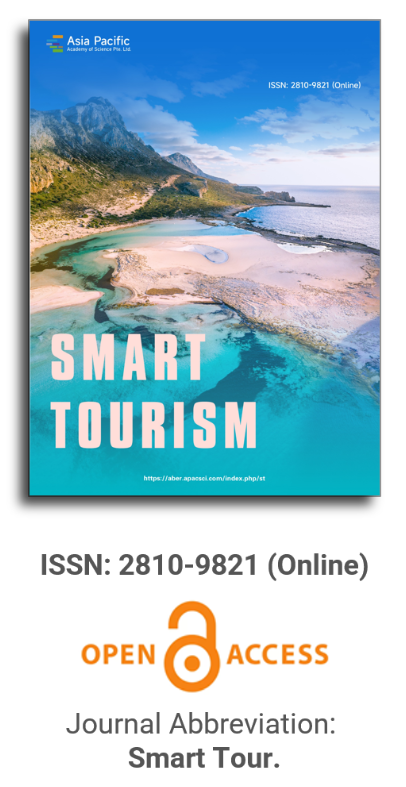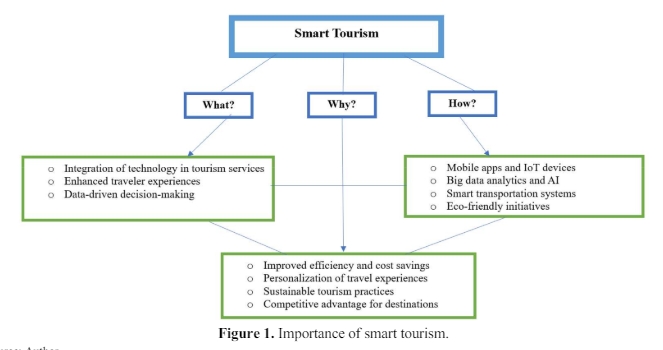


From the perspective of the visitor, smart beach management: Rosarito, Baja California, Mexico
Vol 3, Issue 1, 2022
Download PDF
Abstract
As tourism sites, beaches offer opportunities for implementing technology solutions to streamline decision-making. The aim of this research is to examine the potential for intelligent beach management in Rosarito, Baja California, Mexico, as seen by visitors. This analysis will take into account the utilization of technology to facilitate social distancing measures, capacity control, and ICT for interpersonal communication. Based on a non-experimental, transactional field design, the methodology is quantitative. A probability sample of 595 visitors who were sent a questionnaire via the Internet between July and October 2020 was computed with a 95% confidence level and 4% error rate. The results of the multiple regression analysis show that the dependent variable, perception of confidence to visit the municipality's beaches, is related to the variables technologies to comply with the recommendations of social distancing from the COVID-19 pandemic, technologies to control access to the beach, and ICT to know the conditions of the tourist area. By implementing these technology components, the tourism industry will be able to continue operating while adhering to the relevant health and safety regulations.
Keywords
References
- Landazury LF, Ferrer F. Innovación como eje transversal de los modelos de negocio en las organizaciones, una revisión del constructo teórico (Spanish) [Innovation as a transversal axis of business models in organizations, a review of the theoretical construct]. Revista Escuela de Administración de Negocios 2016; (81): 129–147.
- Chaves MD. Sistema de inteligencia territorial de apoyo al emprendimiento (Spanish) [Territorial intelligence system to support entrepreneurship]. Revista de Ciencias Sociales 2021; XXVII(1): 11–14.
- Martin-Fiorino V, Reyes GE. Desafíos y nuevos escenarios gerenciales como parte de la herencia del COVID-19 (Spanish) [Challenges and new management scenarios as part of the COVID-19 legacy]. Revista Venezolana de Gerencia 2020; 25(90): 722–734.
- Ferrandis A, Sánchez JV, Torres Á, et al. Las playas inteligentes: La mejor alternativa para la gestión de playas poscoronavirus (Spanish) [Smart beaches: The best alternative for post-coronavirus beach management]. Spain: Universidad de la Laguna; 2020. p. 238–253.
- Aguirre JP. Caída del turismo por la COVID-19 Desafío para México y experiencias internacionales (Spanish) [COVID-19 tourism decline Challenge for Mexico and international experiences]. Mirada Legislativa 2020; (186): 1–16.
- Segura O, Hernández J, López M. Cuadernos de Politica Económica 001-2020 (Spanish) [Economic Policy Notebooks 001-2020] [Internet]. 2020. Available from: https://repositorio.una.ac.cr/bitstream/handle/11056/17401/Cuaderno-001-2020%20CIS-Estado%20del%20Art%20%20Segura-Hernndez-Lopez%20.pdf?sequence= 1 &isAllowed=y.
- Linares J, Vásquez KB. Ciudades inteligentes: Materialización de la sostenibilidad (Spanish) [Smart cities: Materializing sustainability]. Revista de Ciencias Sociales 2018; 18(2): 479–495.
- Sociedad Estatal para la Gestión de la Innovación y las Tecnologias Turísticas. Informe destinos turisticos inteligentes: Construyendo el futuro (Spanish) [Smart destinations report: Building the future] [Internet]. SEGITTUR; 2015. Available from: https://www.thinktur.org/media/Libro-Blanco-Destinos-Tursticos-Inteligentes-construyendo-elfturo.pdf.
- Secretaria de Turismo - SECTUR. Secretaría de Turismo: Comunicado 032/2020. Disminuyen operaciones áreas y ocupación hotelera por contingencia (Spanish) [Secretariat of Tourism: Communiqué 032/2020. Disminuyen operaciones áreas y ocupación hotelera por contingencia] [Internet]. 2020. Available from: https://www.gob.mx/sectur/prensa/disminuyen-operaciones-aereas-y-ocupacion-hotelera-por-contingencia.
- Comité de Planeación del Desarrollo - COPLADE. Playas de Rosarito (Spanish) [Beaches of Rosarito] [Internet]. Gobierno de Baja California; 2017. Available from: http://www.copladebc.gob.mx/publicaciones/2017/Mensual/Playas%20de%20Rosarito.pdf
- DATATUR. Compendio estadístico 2019 de la actividad hotelera (Spanish) [2019 statistical compendium on hotel activity] [Internet]. DATATUR; 2019. Available from: https://www.datatur.sectur.gob.mx/SitePages/ActividadHotelera.Aspx.
- Baja-California. Playas de Rosarito: El destino de sol y playa por tradición (Spanish) [Playas de Rosarito: The sun and beach destination by tradition] [Internet]. Fideicomiso Público para la Promoción Turística del Estado de Baja California. 2020. Available from: https://rosarito.travel/.
- Korstanje ME. El COVID-19 y el turismo rural: Una perspectiva antropológica (Spanish) [COVID-19 and rural tourism: An anthropological perspective]. Dimensiones Turísticas 2020; 4(E): 179–196.
- Organización Mundial del Turismo - OMT. Evaluación del impacto del brote de COVID-19 en el turismo internacional: Barómetro OMT del Turismo Mundial mayo 2020 (Spanish) [Assessing the impact of the COVID-19 outbreak on international tourism: UNWTO World Tourism Barometer May 2020]. OMT; 2020. Available from: https://www.unwto.org/es/evaluacion-de-la-incidencia-del-brote-del-covid-19-en-el-turismo-internacional.
- González A. Vulnerabilidad cuando se depende del turismo: COVID-19 en Quintana Roo, México (Spanish) [Vulnerability when dependent on tourism: COVID-19 in Quintana Roo, Mexico]. Desarrollo, Economía y Sociedad 2020; 9(1): 15–28.
- De Sá FZ. Mobilidade da produção científica sobre turismo e COVID-19 (Spanish) [Mobility of scientific production on tourism and COVID-19]. Rosa dos Ventos 2020; 12(Esp. 3): 1–2. doi: 10.18226/21789061.v12i3a11.
- Loor L, Plaza N, Medina Z. Turismo comunitario en Ecuador: Apuntes en tiempos de pandemia (Spanish) [Community-based tourism in Ecuador: Notes in times of pandemic]. Revista de Ciencias Sociales 2020; XXVII(1): 265–277.
- Vargas A. Entender el turismo post-coronavirus: Posibles escenarios (Spanish) [Understanding post-coronavirus tourism: Possible scenarios]. In: Bauzá FJ, Melgoza FJ (editors). Turismo post COVID-19: El Turismo después de la pandemia global, análisis, perspectivas y vías de recuperación Madrid. Madrid: AECIT; 2020. p. 15–40.
- Instituto Nacional de Estadística y Geografía - INEGI. Cuenta Satélite del Turismo de México, 2018 (Spanish) [Mexico Tourism Satellite Account, 2018] [Internet]. Instituto Nacional de Estadística y Geografía; 2018. Available from: https://www.inegi.org.mx/app/saladeprensa/noticia.html?id=5451.
- Instituto Nacional de Estadística y Geografia. Encuestas de viajeros internacionales (Spanish) [Surveys of international travelers] [Internet]. nstituto Nacional de Estadística y Geografía; 2020. Available from: https://www.inegi.org.mx/contenidos/saladeprensa/notasinformativas/2020/ViajInternales/ViajInternales2020_09.pdf.
- Bringas N. Los impactos del COVID-19 en el turismo de la frontera norte de México (Spanish) [The impacts of COVID-19 on tourism in Mexico’s northern border region] [Internet]. El Colegio de la Frontera Norte; 2021. Available from: https://www.colef.mx/opinion/los-impactos-del-covid-19-en-el-turismo-de-la-frontera-norte-de-mexico/?e=correo-fronterizo.
- Organización Mundial del Turismo - OMT. COVID-19 y la transformación del Turismo (Spanish) [COVID-19 and the transformation of Tourism] [Internet]. OMT; 2020. Available from: https://www.unwto.org/es/news/informe-de-politicas-sobre-el- turismo-y-la-covid-19.
- Ferreira R, Medaglia J, Stadler A. Destinos turísticos inteligentes e gestão do conhecimento: Possíveis convergências (Spanish) [Intelligent tourist destinations and knowledge management: Possible convergences]. AtoZ Novas Práticas em Informação e Conhecimento 2020; 9(1): 61–73.
- Alderete MV. Qué factores influyen en la construcción de ciudades inteligentes un modelo multinivel con datos a nivel ciudades y países (Spanish) [What factors influence the construction of smart cities a multilevel model with city and country-level data]. Revista Iberoamericana de Ciencia, Tecnología y Sociedad-CTS 2019; 14(41): 71–89.
- Nascimento LA. Destinos turísticos inteligentes e desenvolvimento sustentável: Uma revisão sistemática da literatura científica (Spanish) [Smart tourism destinations and sustainable development: A systematic review of the scientific literature]. CULTUR-Revista de Cultura e Turismo 2020; 14(1): 1–17.
- Lamfus C, Martín D, Alzua-Sorzabal A, et al. Smart tourism destinations: An extended conception of smart cities focusing on human mobility. Springer International Publishing 2014; (2): 363–375.
- Pinon MA, Cartillejos B. Huatulco desde la perspectiva de los destinos inteligentes (Spanish) [Huatulco from the perspective of smart destinations]. Turismo y Sociedad 2019; 25: 73–92.
- Jeong M, Shin H. Tourists, experiences with smart tourism technology at smart destinations and their behavior intentions. Journal of Travel Research 2020; 59(8): 1464–1477.
- Flores D, Perogil J, Miedes B. Destinos turísticos inteligentes o territorios inteligentes estudios de casos en Espana (Spanish) [Smart destinations or smart territories case studies in Spanish]. Revista de Estudios Regionales 2018; (113): 193–219.
- Femenia-Serra F, Neuhofer B, Ivars-Baida JA. Towards a conceptualization of smart tourists and their role within the smart destination scenario. The Service Industries Journal 2019; 39(2): 109–133.
- Instituto Valenciano de Tecnologías Turísticas - INVAT-TUR. Destinos turísticos Inteligentes: Manual operativo para la configuración de Destinos Turísticos Inteligentes (Spanish) [Smart Tourist Destinations: Operational Manual for the configuration of Intelligent Tourist Destinations] [Internet]. Instituto Universitario de Investigaciones Turísticas; 2015. Available from: https://www.thinktur.org/media/Manual-de-destinos-tur%C3%ADsticos-inteligentes.pdf.
- Instituto Valenciano de Tecnologías Turísticas - INVAT-TUR. La transformación digital: El modelo de playas inteligentes de la comunidad valenciana (Spanish) [Digital transformation: The model of intelligent beaches of the Valencian community] [Internet]. Turisme Comunitat Valenciana; 2018. Available from: http://www.turismecv.com/wp-content/uploads/2018/11/Ebook-playas-inteligentes-OK.pdf.
- James RJ. From beaches to beach environments: Linking the ecology, human-use and management of beaches in Australia. Ocean & Coastal Management 2000; 43(6): 495–514.
- Fischer L, Espejo J. Introducción a la investigación de mercados (Spanish) [Introduction to market research]. McGraw-Hill; 2017.
- Oviedo HC, Campo-Arias A. Aproximación al uso del coeficiente alfa de Cronbach (Spanish) [Approximation to the use of Cronbach’s alpha coefficient]. Revista Colombiana de Psiquiatria 2005; 34(4): 572–580.
- Fernández A, López JM, Moreno L, et al. Innovación y destinos inteligentes: Oportunidad para el know how turístico espanol (Spanish) [Innovation and smart destinations: Opportunity for Spanish tourism know-how]. ICE 2017; (894): 137–150.
- Grupo Interinstitucional de Investigación-GIDI. Impactos de COVID-19 en las empresas de Baja California: Encuesta de impactos (Spanish) [Impacts of COVID-19 on Baja California companies: Impact survey] [Internet]. El Colegio de la Frontera Norte; 2020. Available from: https://www.clacso.org/wp-content/uploads/2020/06/ GIDI2.pdf.
- Hinton PR, McMuray I, Browlow C. SPSS explained. Routledge; 2014. doi: 10.4324/9781315797298.
- Instituto Valenciano de Tecnologías Turísticas - INVAT-TUR. Playas inteligentes y seguras de la Comunitat Valenciana (Spanish) [Intelligent and safe beaches in the Valencian Region] [Internet]. INVAT-TUR; 2020. Available from: https://www.invattur.es/playas-inteligentes-y-seguras/.
- Comisión Económica para América Latina y el Caribe - CEPAL. Dimensionar los efectos del COVID-19 para pensar en la reactivación (Spanish) [Sizing the effects of COVID-19 in order to think about reactivation] [Internet]. CEPAL; 2000. Available from: https://repositorio.cepal.org/bitstream/handle/11362/45445/4/S2000286 es.pdf.
Supporting Agencies
Copyright (c) 2022 Isaac Cruz-Estrada, Ana M Miranda-Zavala, Margarita Ramírez-Torres
License URL: https://creativecommons.org/licenses/by/4.0

This site is licensed under a Creative Commons Attribution 4.0 International License (CC BY 4.0).

Prof. Hung-Che Wu
Nanfang College, Guangzhou
China
Indexing & Archiving
Asia Pacific Academy of Science Pte. Ltd. (APACSCI) specializes in international journal publishing. APACSCI adopts the open access publishing model and provides an important communication bridge for academic groups whose interest fields include engineering, technology, medicine, computer, mathematics, agriculture and forestry, and environment.



.jpg)
.jpg)

.jpg)

